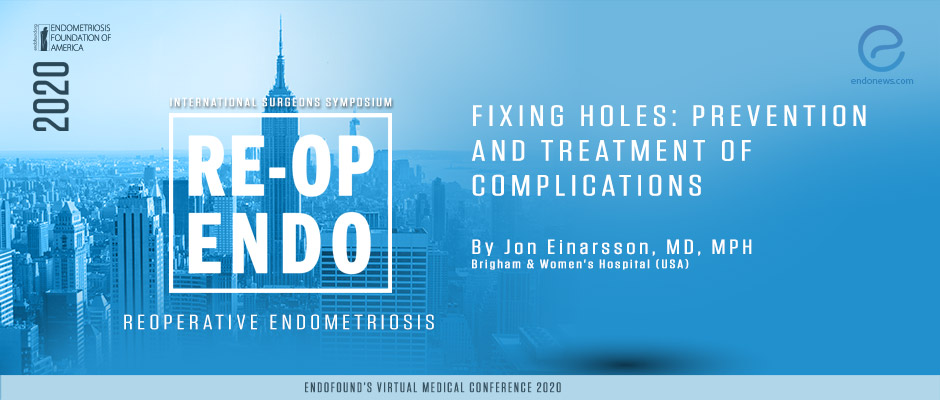Fixing holes: prevention and treatment of complications - Jon Einarsson, MD, MPH
Dec 10, 2020
Deep endometriosis surgery requires awareness of pelvic organ and vessel damage.
Key Points
Information for the presentation: Dr. Einarsson is the Director of the Division of Minimally İnvasive Gynecologic Surgery at Brigham and Women's Hospital and Professor of Obstetrics, Gynecology and Reproductive Biology at Harvard Medical School. The name of his presentation at the 2020 Endofound Medical Conference is " Fixing holes: Prevention and treatment of complications"
Importance:
- Laparoscopic approach for deeply infiltrating endometriosis (DIE) may result in some degree of complications in the urinary tract, gastrointestinal tract, or vascular damage. Thermal injury is the cause of most of these complications in recent years.
Highlights:
- To prevent the surgical complications of DIE, the surgeon should excise the endometriotic nodules near or inside the bladder, ureter, and bowel in a controlled manner. The best way to solve the problem is to surgically cut these involved organs on purpose and to repair them appropriately afterward.
Remarks:
- If the foley bag is full of gas it may cause bladder injury.
- If the surgeon is unsure of bladder margins or to locate the injury, the recommended way is to backfill the bladder via a three-way catheter.
- Normal urine flow does not always equate to the ureter or bladder integrity.
- The dome of the bladder is the most affected area in endometriosis surgery. The easiest way is to cut the bladder from its dome on purpose because this is the safest way to address it.
- Even though cystoscopy is important during endometriosis surgery, it's not completely reliable to rule out urinary tract injuries which are mostly created by thermal contacts.
- Dr. Jon Einarsson does not recommend mechanical bowel preparation preoperatively because it does not help the prognosis, and it also increases the discomfort of the patient.
- Opening the rectum is usually not important as long as the defect is repaired adequately.
- The reason for thermal injury resulting in morbidities is always having a low suspicion for thermal injury.
- During the endometriosis surgery surgeon should pay close attention to the internal iliac vein area to avoid unexpected vascular injuries.
Lay Summary
Dr. Einarsson shared his operating room video screens during his speech for discussing four major complications (ureter, bladder, bowel, and vascular) of endometriosis surgery and the ways to repair them.
Fixing the ureter damage: Endometriotic nodules may settle on the tract of ureters, and their removal may cause ureteral damage. The best way to approach this is to cut them from their healthy surface and restore end-to-end anastomosis. Separation of the ureter surface very carefully and passing a stent while constructing end-to-end anastomosis is the successful way to approach it. The stent should be left for six weeks and could be removed in the office.
As a rare condition, the damaged segment could be very near to the ureteral orifice, which needs reimplantation of the ureter to the bladder. At the end of the process, the surgeon needs to follow and make sure of the urine output.
Fixing the bladder damage: Usually, endometriotic nodules affect the dome of the bladder. Cutting the dome on purpose after liberating it from the nearby adhesions is effective. If the nodule is close to the trigone or one of the ureter orifice, placement of stents before the maintenance. Resected ureter should be reimplanted. During the suturing of two-layers of the bladder for closure, the second layer should overlap with the first layer. Confirmation of an intact suture line without leakage of urine is essential.
Fixing the bowel damage: Following a trocar insertion, a simple puncture of the small bowel may occur, and this can often be sutured laparoscopically or via mini-laparotomy. Opening the rectum when there is an endometriotic mass close to it is common. After aspirating the inner space and preparing the bowel, a two-layered suture should be performed to close the wall of the rectum. İmbricating the second layer to the first one is important. When one-third of the circumference of the bowel is damaged, the better way to repair is resection and anastomosis of the bowel. Major thermal injuries should be maintained by resection and anastomosis.
Fixing emergency unwilling vascular damages: During endometriosis surgery to remove the mass lesions from the lateral space of the uterus may cause vascular damages. The important issue is dissecting the internal iliac vein early to prevent major bleeding. To dig holes in this area should be avoided. The surgeon should be aware of the superior gluteal artery that crosses over the operation area in this lateral space.
Research Source: https://www.endofound.org/fixing-holes-prevention-and-treatment-of-complications-jon-ivar-einarsson-md-phd-mph?pop=mc
laparoscopy postoperative complications bladder ureter colon internal iliac vein superior gluteal artery deeply invasive endometriosis mc2020

